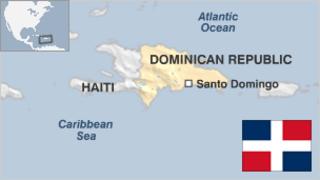Home » Latin America »
Dominican Republic country profile
Once ruled by Spain, the Dominican Republic shares the island of Hispaniola with Haiti, a former French colony.
The Caribbean nation is a major tourist destination. This, coupled with free-trade zones, has become the country’s major employer and key sources of revenue, replacing dependence on sugar, coffee and other exports.
The Dominican Republic is inhabited mostly by people of mixed European and African origins. Western influence is seen in the colonial buildings of the capital, Santo Domingo, as well as in art and literature. African heritage is reflected in music.
FACTS
Dominican Republic
Capital: Santo Domingo
Population 10.6 million
Area 48,072 sq km (18,696 sq miles)
Major language Spanish
Major religion Christianity
Life expectancy 71 years (men), 77 years (women)
Currency Dominican peso
LEADERS
President: Danilo Medina
Danilo Medina Sanchez was re-elected as president in May 2016.
He first came to power on 16 August 2012, succeeding three-times President Leonel Fernandez Reyna.
He is an economist and long-standing member of the Dominican Liberation Party (PLD).
Until 2015 the constitution barred him from running for a second straight term, but a constitutional change allowed him to seek re-election in 2016.
He has controversially overseen the relaxation of abortion laws and the introduction of a naturalization law which led to the descendants of thousands of Haitian immigrants becoming stateless.
MEDIA
Media ownership is concentrated in a few influential hands. There are scores of terrestrial TV channels and hundreds of radio stations, most of them commercial.
Journalists reporting on drug crime and corruption are exposed to possible threats.
TIMELINE
Some key dates in the history of the Dominican Republic:
1492 – Christopher Columbus visits the island, which he names Hispaniola, or “Little Spain”.
1496 – Spaniards set up first Spanish colony in Western hemisphere at Santo Domingo, which subsequently serves as capital of all Spanish colonies in America.
1697 – Treaty of Ryswick gives western part of Hispaniola island (Haiti) to France and eastern part (Santo Domingo – the present Dominican Republic) to Spain.
1795 – Spain cedes its portion of Hispaniola island to France.
1808 – Spain retakes Santo Domingo following revolt by Spanish Creoles.
1821 – Uprising against Spanish rules is followed by brief period of independence.
1822 – Haitian President Jean-Pierre Boyer marches his troops into Santo Domingo and annexes it.
1844 – Boyer overthrown; Santo Domingo declares its independence and becomes the Dominican Republic.
1861-64 – President Pedro Santana returns the Dominican Republic to Spanish rule. Spain withdraws from, and annuls its annexation of, the Dominican Republic following a popular revolt.
1865 – The second Dominican Republic proclaimed.
1906 – Dominican Republic and US sign 50-year treaty according to which the US takes over the republic’s customs department in return for buying its debts.
1916-24 – US forces occupy the Dominican Republic following internal disorder.
1924 – Constitutional government assumes control; US forces withdraw.
1930-1961 – General Rafael Leonidas Trujillo Molina establishes personal dictatorship following the overthrow of President Horacio Vazquez. He rules the country until his assassination in 1961.
Source: Read Full Article



